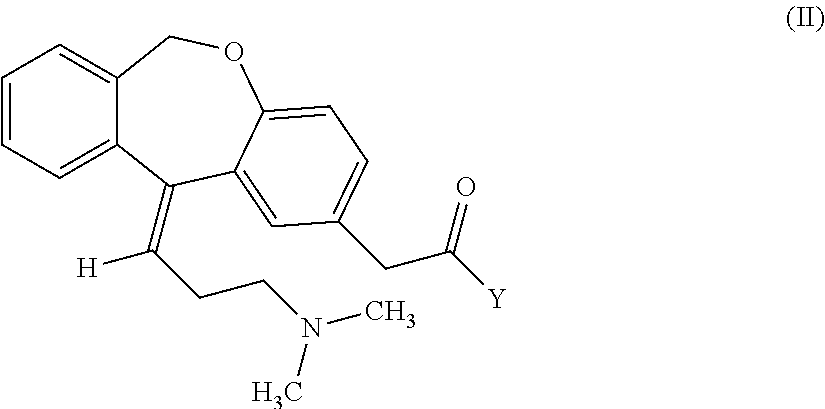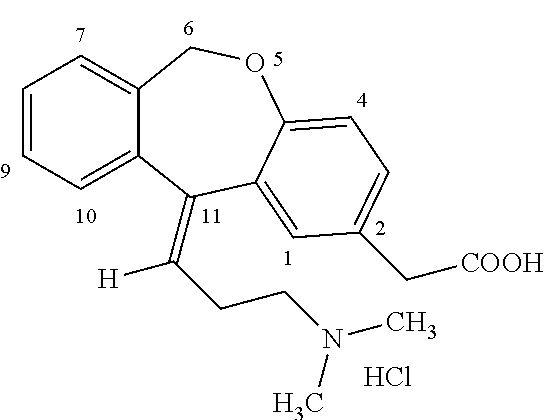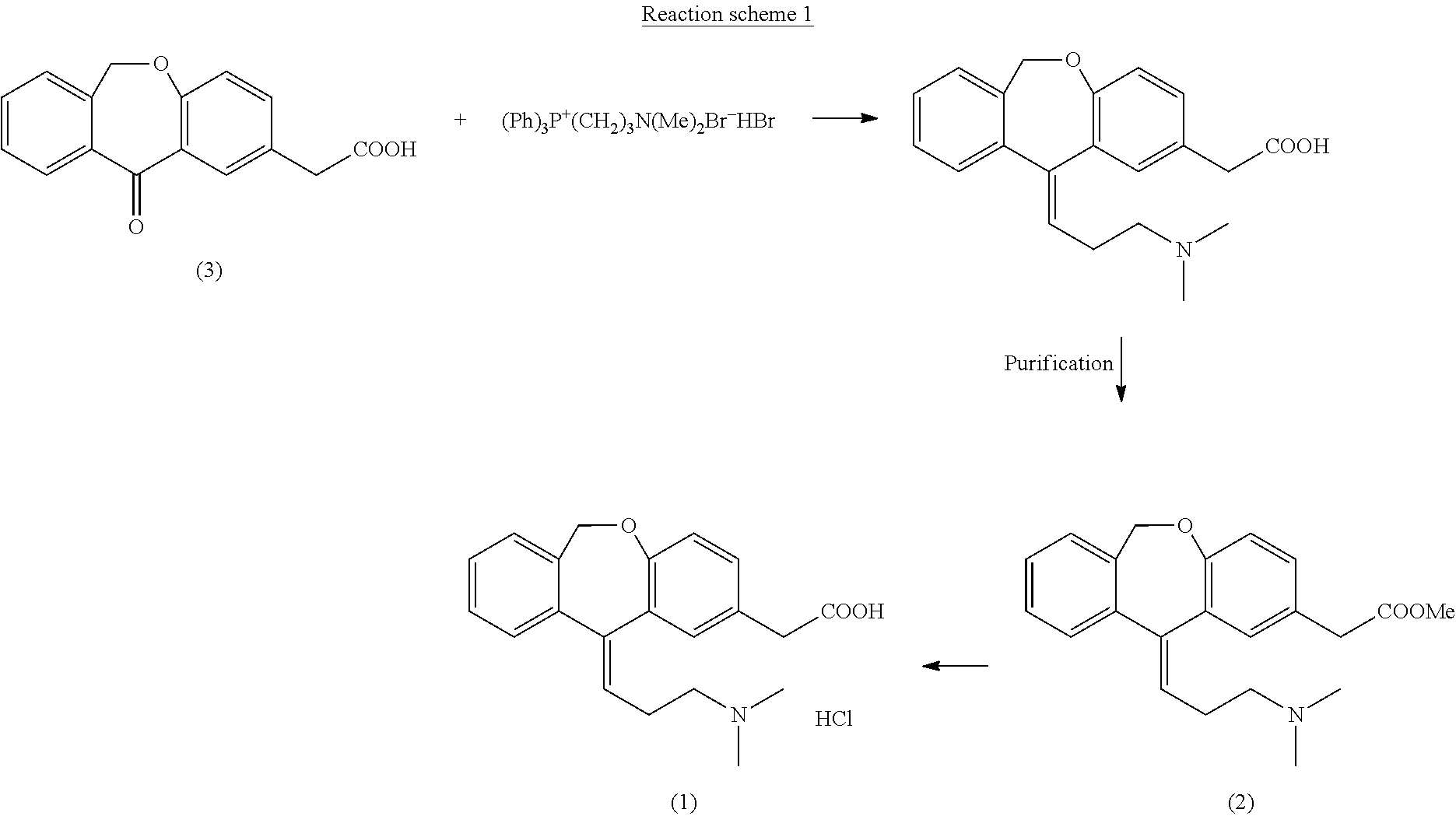Process for obtaining olopatadine and intermediates
a technology of olopatadine and intermediates, which is applied in the field of process for obtaining olopatadine and intermediates, can solve the problems of increasing the cost of the process, low yield of the process, and high cost of the global process, so as to improve the isolation effect, and improve the purity of the produ
- Summary
- Abstract
- Description
- Claims
- Application Information
AI Technical Summary
Benefits of technology
Problems solved by technology
Method used
Image
Examples
example 1
Ethyl 6,11-dihydro-11-oxodibenz[b,e]oxepin-2-yl acetate
[0110]10 g (0.037 moles) of 6,11-dihydro-11-oxodibenz[b,e]oxepin-2-acetic acid were dissolved in 50 ml of ethanol (EtOH) and 1 g (0.005 moles) of p-toluenesulfonic acid (p-TsOH) was added to this solution. The resulting solution was heated under reflux, distilling EtOH (10 ml) at atmospheric pressure which was put back immediately in the reaction medium. This operation was repeated several times for 90 minutes. After this time period, the reaction was cooled to 20-25° C. and 0.54 g (0.005 moles) of potassium acetate were added. Then, it was concentrated under reduced pressure until obtaining a residue on which 40 ml of CH2Cl2 and 10 ml of H2O were added. The mixture was stirred for 5 minutes and decanted, the organic phase being separated from the aqueous phase. The organic phase was concentrated under reduced pressure until obtaining a residue on which 20 ml of ethyl acetate (AcOEt) were added. The resulting suspension was stir...
example 2
Isopropyl 6,11-dihydro-11-oxodibenz[b,e]oxepin-2-yl acetate
[0114]10 g (0.037 moles) of 6,11-dihydro-11-oxodibenz[b,e]oxepin-2-acetic acid were dissolved in 150 ml of isopropanol (iPrOH) and 2 g (0.01 moles) of p-toluenesulfonic acid (p-TsOH) were added to this solution. The resulting solution was heated under reflux, distilling 100 ml of iPrOH from the reaction medium. The reaction was cooled to 40-45° C. and 1 ml (0.007 ml) of Et3N was added. Then, the reaction mixture was left to cool to 20-25° C. and stirring was maintained at this temperature for 30 minutes. Then, the suspension was left to cool to 5-10° C., it was filtered and the resulting product was washed with iPrOH. 11 g (0.035 moles, 96%) of a white solid identified as the compound of the title were obtained, the spectroscopic properties of which are:
[0115]1H-NMR (CDCl3, 400 MHz), δ: 1.21 (d, 6H); 3.59 (s, 2H); 4.12 (m, 1H); 5.11 (s, 2H), 6.97 (d, 1H); 7.29 (d, 1H); 7.38 (m, 2H); 7.47 (m, 1H); 7.84 (d, 1H); 8.08 (d, 1H) p...
example 3
Benzyl 6,11-dihydro-11-oxodibenz[b,e]oxepin-2-yl acetate
[0118]10 g (0.037 moles) of 6,11-dihydro-11-oxodibenz[b,e]oxepin-2-acetic acid were dissolved in 100 ml of toluene and 2 g (0.01 moles) of p-toluenesulfonic acid (p-TsOH) and 17.5 ml (0.169 moles) of benzyl alcohol were added to this solution. The reaction was equipped with a Dean-Stark, a mixture of water / toluene thus being distilled. The reaction was maintained until 0.7 ml of water were collected. The reaction was left to cool to 20-25° C., at which temperature 1.5 ml (0.011 moles) of Et3N were added. The resulting solution was concentrated under reduced pressure until obtaining a residue which was dissolved in isopropanol (50 ml), giving rise to a suspension. The obtained suspension was stirred at 20-25° C. for 30 minutes, then being cooled at 0-5° C. Stirring was maintained at this temperature for 30 minutes. Then, the suspension was filtered and washed, obtaining 12.5 g (0.036 moles, 98%) of a white solid identified as th...
PUM
| Property | Measurement | Unit |
|---|---|---|
| steric volume | aaaaa | aaaaa |
| polar | aaaaa | aaaaa |
| organic polar aprotic | aaaaa | aaaaa |
Abstract
Description
Claims
Application Information
 Login to View More
Login to View More - R&D
- Intellectual Property
- Life Sciences
- Materials
- Tech Scout
- Unparalleled Data Quality
- Higher Quality Content
- 60% Fewer Hallucinations
Browse by: Latest US Patents, China's latest patents, Technical Efficacy Thesaurus, Application Domain, Technology Topic, Popular Technical Reports.
© 2025 PatSnap. All rights reserved.Legal|Privacy policy|Modern Slavery Act Transparency Statement|Sitemap|About US| Contact US: help@patsnap.com



